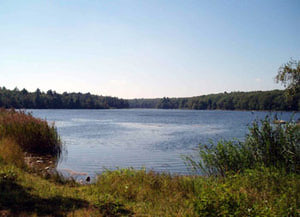Freshwater Lakes: Difference between revisions
No edit summary |
No edit summary |
||
| Line 3: | Line 3: | ||
Freshwater lakes are bodies of still, unsalted water surrounded by land. They are usually found in low laying areas and are fed from streams, rivers and runoff from the surrounding area. Freshwater lakes provide a unique habitat for microbes because they differ from other aquatic habitats such as oceans and moving water. This habitat is home to a plethora of microbes such as proteobacteria, actinobacteria, cyanobacteria, and bacteroidetes. These microbes help sequester inorganic compounds, mineralize nitrogen, and decompose organic matter, as well as other important processes. | Freshwater lakes are bodies of still, unsalted water surrounded by land. They are usually found in low laying areas and are fed from streams, rivers and runoff from the surrounding area. Freshwater lakes provide a unique habitat for microbes because they differ from other aquatic habitats such as oceans and moving water. This habitat is home to a plethora of microbes such as proteobacteria, actinobacteria, cyanobacteria, and bacteroidetes. These microbes help sequester inorganic compounds, mineralize nitrogen, and decompose organic matter, as well as other important processes. | ||
[[Image: | [[Image:lake2.jpg|thumb|300px|right|Electron micrograph of the Ebola Zaire virus. This was the first photo ever taken of the virus, on 10/13/1976. By Dr. F.A. Murphy, now at U.C. Davis, then at the CDC.]] | ||
<br>At right is a sample image insertion. It works for any image uploaded anywhere to MicrobeWiki. The insertion code consists of: | <br>At right is a sample image insertion. It works for any image uploaded anywhere to MicrobeWiki. The insertion code consists of: | ||
<br><b>Double brackets:</b> [[ | <br><b>Double brackets:</b> [[ | ||
Revision as of 19:13, 5 April 2012
Introduction
Freshwater lakes are bodies of still, unsalted water surrounded by land. They are usually found in low laying areas and are fed from streams, rivers and runoff from the surrounding area. Freshwater lakes provide a unique habitat for microbes because they differ from other aquatic habitats such as oceans and moving water. This habitat is home to a plethora of microbes such as proteobacteria, actinobacteria, cyanobacteria, and bacteroidetes. These microbes help sequester inorganic compounds, mineralize nitrogen, and decompose organic matter, as well as other important processes.
At right is a sample image insertion. It works for any image uploaded anywhere to MicrobeWiki. The insertion code consists of:
Double brackets: [[
Filename: PHIL_1181_lores.jpg
Thumbnail status: |thumb|
Pixel size: |300px|
Placement on page: |right|
Legend/credit: Electron micrograph of the Ebola Zaire virus. This was the first photo ever taken of the virus, on 10/13/1976. By Dr. F.A. Murphy, now at U.C. Davis, then at the CDC.
Closed double brackets: ]]
Other examples:
Bold
Italic
Subscript: H2O
Superscript: Fe3+
This template gives you a general idea of the layout of your page. You are not completely restricted to this format, so feel free to try out different things. I'll give you feedback as you work on your pages. Make sure to copy the "code" of this page to your own page before editing. -Prof Kent
In the introduction, briefly describe the habitat that is the topic of this page. Introduce the habitat, its ecological significance, and the importance of microorganisms in this environment. (What processes do they carry out? What functions do they perform?)
Physical environment
Describe the physical and chemical characteristics of the environment, using as many sections/subsections as you require. If it is appropriate, you can divide the physical and chemical attributes of the environment into separate sections. Look at other topics available in MicrobeWiki. Which involve processes similar to yours? Create links where relevant.
Subsection 1
Subsection 1a
Subsection 1b
Subsection 2
Microbial communities
What kind of microbes do we typically find in this environment? Or associated with important processes in this environment? Describe key groups of microbes that we find in this environment, and any special adaptations they may have evolved to survive in this environment. List examples of specific microbes that represent key groups or are associated with important processes found in this environment. Link to other MicrobeWiki pages where possible.
Are there important biological interactions that are important in this environment? Do these interactions influence microbial populations and their activities? How do these interactions influence other organisms? Describe biological interactions that might take place in this environment, using as many sections/subsections as you require. Look at other topics available in MicrobeWiki. Create links where relevant.
Subsection 1
Subsection 1a
Subsection 1b
Subsection 2
Microbial processes
What microbial processes define this environment? Describe microbial processes that are important in this habitat, adding sections/subsections as needed. Look at other topics in MicrobeWiki. Are some of these processes already described? Create links where relevant.
Subsection 1
Subsection 1a
Subsection 1b
Subsection 2
Current Research
Enter summaries of recent research here--at least three required
References
Edited by <your name>, a student of Angela Kent at the University of Illinois at Urbana-Champaign.

